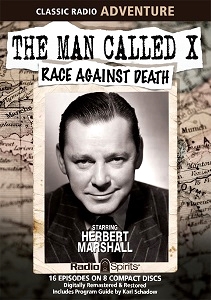
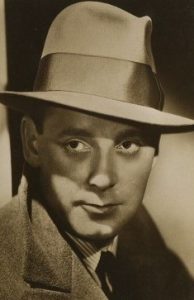 The Man Called X (1944-45, 1946, 1947-48, 1950-52) aired “The Desert of Death—Kabul, Afghanistan” on May 6, 1952 as the 83rd episode of the 86 aired during the 1950-52 run. The only other episodes of this program we have showcased were from February of 2019, January and September of 2020, April of 2021 and February of 2022. Estimates are that there were 227 episodes from all years and that only 103 still exist, with 98 coming from the 1947-48 and 1950-52 runs. Well known and highly regarded British actor Herbert Marshall (1890-1966) played Ken Thurston, known as the eponymous Man Called X. He was an intelligence agent for the British, much as Brian Donlevy played undercover intelligence operative Steve Mitchell for the Americans in Dangerous Assignment. Marshall would star in all but three or four episodes of what came to be known as his series, and that includes every episode from 1944 through 1952, during which time he could be seen in any number of Hollywood films, appearing in varying roles with stars such as Marlene Dietrich, Greta Garbo, Bette Davis, Katherine Hepburn, Joan Crawford, Fredric March, Tony Curtis, Rex Harrison, and others too numerous to mention. Of genre interest he appeared as Inspector Charas in 1958’s classic SF film The Fly, which starred Vincent Price. Marshall lost his right leg in World War I, and wishing to do his part but unable to fight in WWII, at his own expense he traveled to numerous military hospitals in the United States and encouraged other amputees to remain positive and not think of themselves as handicapped. He would also appear often on the Armed Forces Radio Service (AFRS) as host of the popular war-time program The Globe Theater. From his other war-time projects as well as several films in which he starred, the proceeds went to several war charities. Marshall had not only worked in film since 1927 as both character actor and leading man, but along with his role in The Man Called X would have roles in at least a half dozen other radio programs, and would work in television in his later years, including two episodes of Alfred Hitchcock Presents and a recurring role in 77 Sunset Strip (1958-64). For his achievements in all of these media Marshall received a star on the Hollywood Walk of Fame in 1960.
The Man Called X (1944-45, 1946, 1947-48, 1950-52) aired “The Desert of Death—Kabul, Afghanistan” on May 6, 1952 as the 83rd episode of the 86 aired during the 1950-52 run. The only other episodes of this program we have showcased were from February of 2019, January and September of 2020, April of 2021 and February of 2022. Estimates are that there were 227 episodes from all years and that only 103 still exist, with 98 coming from the 1947-48 and 1950-52 runs. Well known and highly regarded British actor Herbert Marshall (1890-1966) played Ken Thurston, known as the eponymous Man Called X. He was an intelligence agent for the British, much as Brian Donlevy played undercover intelligence operative Steve Mitchell for the Americans in Dangerous Assignment. Marshall would star in all but three or four episodes of what came to be known as his series, and that includes every episode from 1944 through 1952, during which time he could be seen in any number of Hollywood films, appearing in varying roles with stars such as Marlene Dietrich, Greta Garbo, Bette Davis, Katherine Hepburn, Joan Crawford, Fredric March, Tony Curtis, Rex Harrison, and others too numerous to mention. Of genre interest he appeared as Inspector Charas in 1958’s classic SF film The Fly, which starred Vincent Price. Marshall lost his right leg in World War I, and wishing to do his part but unable to fight in WWII, at his own expense he traveled to numerous military hospitals in the United States and encouraged other amputees to remain positive and not think of themselves as handicapped. He would also appear often on the Armed Forces Radio Service (AFRS) as host of the popular war-time program The Globe Theater. From his other war-time projects as well as several films in which he starred, the proceeds went to several war charities. Marshall had not only worked in film since 1927 as both character actor and leading man, but along with his role in The Man Called X would have roles in at least a half dozen other radio programs, and would work in television in his later years, including two episodes of Alfred Hitchcock Presents and a recurring role in 77 Sunset Strip (1958-64). For his achievements in all of these media Marshall received a star on the Hollywood Walk of Fame in 1960.
“The Desert of Death” takes place during the Cold War between the United States and the then U.S.S.R. (the Union of Soviet Socialist Republics—now Russia). The advent of the atomic bomb in 1945 ended WWII in the Pacific, and the race for even more powerful nuclear weapons was soon underway. The United States began testing its Hydrogen bomb in December of 1952, and the Soviets soon after in August of 1953. Both sides would have the beginnings of a true H-bomb arsenal by 1955. This episode of The Man Called X aired a scant few months before the U.S. would test its H-bomb, and the American public was keenly aware of the Cold War and the nuclear weapons race between the US and the Soviet Union from radio and film news segments, and magazine and newspaper articles, so this subject matter was prime story material for radio, with its made to order espionage overtones. When one of our indigenous agents in Afghanistan is murdered, Ken Thurston is sent to investigate. What we know is that the Soviets have discovered a certain powerful radioactive element in Siberia, an element they have code-named M-5. If reports are accurate, it is to be used as a far more powerful trigger for an H-bomb than any before it, and poses a dire threat that might result in WWIII. How this scenario plays out is the heart of this episode, and the task set before the one known only as the man called X is to do everything possible to make sure the Soviets don’t turn part of the planet into “The Desert of Death.”
Play Time: 24:47
{“The Desert of Death” aired on a Tuesday evening in May of 1952. After school the next day the neighborhood gang found themselves at the corner newsstand in the mood for more dangerous adventures, and having stocked up on all the current SF/F magazines they rummaged around for magazines with obvious Good Guys vs. Bad Guys stories. Suspense (1951-52) would last but four issues, but some of the names on the covers were names they were familiar with, for they had read these authors’ stories in SF magazines; names like Ray Bradbury, William Tenn, John Wyndham, Will Jenkins (pen name of Murray Leinster), A. E. van Vogt, and Fritz Leiber, Jr.. Suspense was a quarterly and the issue below was its last. Top Detective Annual 1952 was just what the doctor ordered. It had an annual issue for only three years, from 1951-53 and served as a Year’s Best for detective fans. Two Complete Detective Books (1939-54) was characterized by one source as sort of a forerunner to the book club format, where readers who couldn’t afford full length novels in hardcover could purchase two complete novels under one cover for around a quarter. For its first few years it was a quarterly, then switched to a bi-monthly from 1944-51, then finished its run with only 3 issues a year, the cover below being the first of 1952’s trio of issues.}
[Left: Suspense, Winter/52 – Center: Top Detective Annual 1952 – Right: Two Complete Detective Books, Spring/52]
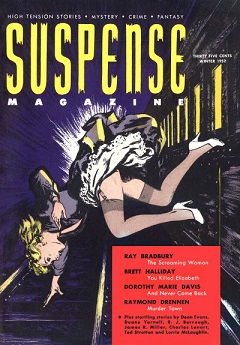
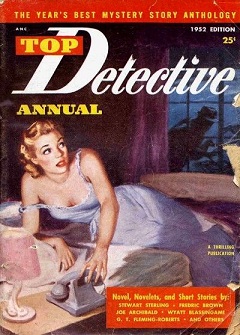
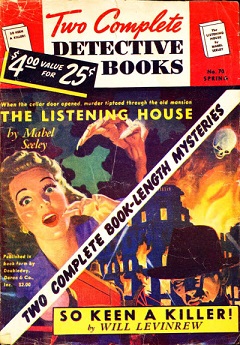
To view the entire list of weekly Old Time Radio episodes at Tangent Online, click here.